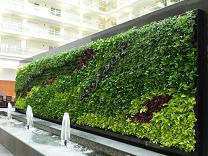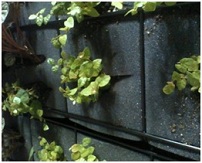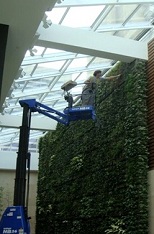 Every year I spend a bit of time at our local AIA trade show. More often than not I’m just renewing friendships and saying hello to architects I’ve worked with over my 30 plus years as an interiorscaper. However, a couple of years ago we featured three large photos, one of a green roof, one of a greenwall and one of green plants—and did we have action at our booth—everyone wanted to know about greenwalls! The photo was of a project we installed some 17 years ago. So while greenwalls aren’t exactly new, they are an idea whose time has come. You also know that’s true when you see them appearing in McDonald’s advertising and frequently in Whole Food Markets.
Every year I spend a bit of time at our local AIA trade show. More often than not I’m just renewing friendships and saying hello to architects I’ve worked with over my 30 plus years as an interiorscaper. However, a couple of years ago we featured three large photos, one of a green roof, one of a greenwall and one of green plants—and did we have action at our booth—everyone wanted to know about greenwalls! The photo was of a project we installed some 17 years ago. So while greenwalls aren’t exactly new, they are an idea whose time has come. You also know that’s true when you see them appearing in McDonald’s advertising and frequently in Whole Food Markets.
So based upon that trade show experience and a bit of prodding by a good friend to help her with the design of a major greenwall installation, I entered the greenwall product market. Last fall we introduced our product at the Greenbuild Conference in Phoenix. Again, we were swamped and I ran out of literature by 3 p.m. on the first day of the show. So if you’re wondering if this greenwall thing is for real, trust me, it’s for real and we all need to learn as much as we can about the how’s and the wherefores of what makes a greenwall work and what one needs to know to make them successful.
Greenwalls, also known as vertical planting systems, vertical gardens, plant walls or vegetated walls have been successfully implemented in several projects around the world over the past 15 years. European projects and Canadian projects have taken the lead in implementing these planting systems. But even more importantly, nature has been producing spectacular vertical landscapes for thousands of years and also those ivy covered walls of many of our institutions of higher education are also considered greenwalls. When the air is circulated through a greenwall, the wall becomes an active bio-wall air filtration system. Most greenwalls are simply a vertical planting system for both interiors and exteriors of buildings. The basic greenwall system is created by inserting a planting substrate into a modular wall system.
The components of most vertical planting systems include:
• Plants specifically selected to meet the particular design intent. Interior greenwalls use tropical plants, mostly vining, climbing and fern varieties. Exterior greenwalls use sedums and other hardy vines and climbers.
• A modular panel system, to contain the roots and the growing medium.
• An integrated drip irrigation system and control systems.
• Catch basin to control the water runoff, and a structural support system.
Plants stay in place because they are rooted into the growing media which is held in place by the modular wall system and attached to the wall using a structural support system.
Greenwalls act as biofilters, improving air quality by breaking down harmful VOCs (volatile organic compounds) and creating clean oxygen. Greenwalls absorbs carbon dioxide and release oxygen and reduce greenhouse gases in the atmosphere. Exterior greenwalls reduce energy consumption by keeping the building cooler in summer through the plants’ own transpiration process, reducing the need for air-conditioning. Both interior and exterior greenwalls create a sound barrier, reducing noise inside the building.
Where Do Greenwalls Work?
 Greenwalls first made their appearance in zoological exhibits, but they are adaptable to almost any vertical surface. They make a dramatic visual statement. They are attractive, distinctive, and make anybody take notice. Whether a green wall is inside or outside a building, it adds remarkable visual value to the area. It makes a statement that the business cares about the environment.
Greenwalls first made their appearance in zoological exhibits, but they are adaptable to almost any vertical surface. They make a dramatic visual statement. They are attractive, distinctive, and make anybody take notice. Whether a green wall is inside or outside a building, it adds remarkable visual value to the area. It makes a statement that the business cares about the environment.
The single biggest factor to a greenwall’s success is having properly designed systems for maintaining the greenwall. When designing a greenwall we can look to both the successful commercial applications and nature for the basic design of vertical planting systems.
Design Considerations
There are several important design and structural differences between ground level garden design and vertical garden design projects. Here are a few special construction requirements and considerations for developing the vertical garden.
• Protection of the integrity of the structural support system and waterproofing protection of that system.
• Positive drainage throughout the system so that plantings at the bottom of what may be a couple of stories tall of planting will have optimal growing conditions without becoming oversaturated.
• A long-term, lightweight planting medium that in not subject to deterioration through decomposition—normally this is a synthetic or manufactured product.
• Irrigation and fertilization systems to promote optimum plant growth and sustainability.
• Adaptation of the plantings to the environmental conditions.
• Lighting, especially in the interior.
• Provisions for maintenance.
But, the single most important element in the construction of a greenwall is to protect the integrity of the structural components supporting the vertical garden. For this reason there must be waterproofing of exceptional longevity to prevent damage and to reduce the possibility of a long term expensive reconstruction.
Load Bearing Capacity
 You just can’t hang a greenwall on any old wall you have; they can weigh from 12 to 40 plus pounds per square foot once they are fully saturated with water. So please consult with a structural engineer to verify the load bearing capacity of the wall or the structure where you will be hanging the greenwall. There’s nothing worse than having your greenwall fall to the floor.
You just can’t hang a greenwall on any old wall you have; they can weigh from 12 to 40 plus pounds per square foot once they are fully saturated with water. So please consult with a structural engineer to verify the load bearing capacity of the wall or the structure where you will be hanging the greenwall. There’s nothing worse than having your greenwall fall to the floor.
Waterproofing
There are several types of waterproofing available. Fluid applied elastomeric materials offer excellent protection. The planting system is easily protected by a powder coated protection similar to the racks in a dishwasher. Some systems are aluminum and some stainless steel; these systems are for the most part superior, however these materials add significant project costs.
Plants & Planting Provisions
Like any planting the success of this installation will depend upon providing the correct planting media on which the vertical garden is to be planted. Therefore, it is imperative to take care in choosing and installing materials of the highest quality and species conductive to the greenwall environment. This means in an arid area you must use plants that can stand the dry conditions. For an interior greenwall you need to select plants that can take the lighting levels offered by the space. No need to get wildly creative yet, that can come with time. I suggest you go with plants you are fairly certain will work in the environment. We need greenwalls to be successful if we are to keep this trend going.
Drainage Requirements
The drainage and irrigation system can be designed as a closed drainage system or an open system.
In closed drainage systems the water irrigation water is collected and recycled. However, this system needs to have a little water sent to the drain to control the build-up of soluble salts that are left over as the water evaporates. Failure to drain off a portion of the water or to flush the system can result in salts damage to the greenwall. The closed system is more ecological to operate. It does, however, have drawbacks. Should any plant disease be introduced into the plantings it is effectively transmitted throughout the system by the use of recycled water. This drawback can be managed by a process of ultraviolet sanitation of the recycled water, and this is definitely recommended for major greenwall installations where water is recycled.
 In an open system excess irrigation water is discharged into the building’s drainage system. By using an open system the buildup of salts in the planting medium and the sanitation issues are reduced significantly.
In an open system excess irrigation water is discharged into the building’s drainage system. By using an open system the buildup of salts in the planting medium and the sanitation issues are reduced significantly.
In both systems the excess irrigation water must be captured at the base of the greenwall. Anytime you have water free-flowing through the plantings there is bound to be some dripping from the plantings themselves that cannot be avoided. Therefore, you must have a large catchment system or an area at the base of a greenwall that can become a wet surface.
Planting Media
The critical criteria of a suitable planting media for greenwall planting include: lightweight; the ability to hold nutrients; adequate moisture holding capacity; and the capability of developing a firm root zone (for plant stability) yet must easily drain. Additionally, if the system is to become an active greenwall/bio-wall air filtration system the media must provide adequate air exchange. It should be a material that won’t decompose over time. We all know about the tendencies of soilless media to “disappear” in planting beds and the need for topdressing. Well I don’t think topdressing is going to work very well on a vertical surface, so the planting media needs to stay in place for years.
Irrigation
The supply of moisture to the soil mass is critical to the survival of the greenwall. Although it may sound like an elementary process, the supply of moisture to the plants is a rather complex operation. The supply of water, how it will be supplied, and some inherent problems with water types, are all factors to be considered in the design process if the plantings are to be successful and economical.
The relatively thin, well-drained soilless mixtures used in a greenwall cannot provide the plantings with the subsurface water normally available to ground level plantings. Care must be exercised to prevent the planting media from drying out and causing damage to the plant materials. In an open irrigation system a sensor controlled drip irrigation system can manage the irrigation system using a minimum of water.
Ventilation
Good ventilation is necessary in the photosynthesis and transpiration cycles because it helps dissipate the diffused water vapor molecules resulting from transpiration. Therefore, good ventilation is necessary to maintain a normal transpiration rate, which in turn, is necessary for the normal photosynthetic rate. However, placement of HVAC grilles directly next to the planting can result in problems of drying and even burned foliage due to excessive moisture loss (i.e. forced transpiration). This is mainly a problem during the winter heating season when hot, dry, blowing air comes in direct contact with the foliage of the plant.
Drafts
Interior greenwalls should not be subject to drafts of hot or cold air. Even a rapid change of 15 to 20 degrees has the potential to damage foliage plants. Consistent temperatures are best for interior foliage plants. Heat and cold radiation close to exterior glass and doors can and will damage plants, unless it is modified through air circulation.
Temperature
Most interior greenwalls are designed using tropical and semitropical plant materials. This is because those plant materials are adaptable to our human comfort zones. Therefore it is generally recognized that a temperature of 72 degrees F in the winter and 75 degrees F in the summer are acceptable. Night temperatures can and should be 10 degrees cooler, or 62 to 65 degrees F.
Finishes of Surrounding Areas
A greenwall system generates humidity and it is possible through routine operation and maintenance that some dripping or splashing may occur. This should be taken into account when determining the finishes around the greenwall system.
Storage
Provisions should be made for the storage of gardening materials and supplies. This storage should be readily available to the horticultural staff caring for the plantings. Additionally this area can function as the location of the greenwall’s irrigation controller.
Safety and Serviceability
The difficulty in managing a vertical garden is the safety and serviceability of the plantings. Specifically designed lift systems or ladder systems must be included to facilitate routine maintenance.
Maintenance
Regular professional maintenance of the plantings and facilities should be accounted for in budgeting and planning. Special attention must be given to pruning plant materials in order to maintain balance between plant size and root growth (based on limited availability of rooting area). Regular grooming on the plants to remove dead and dying foliage should be accounted for and lift systems designed to facilitate this activity.
Conclusions
There are lots of great examples of greenwalls in commercial applications. Take a minute and Google images to see the broad variety and artistic expression created with greenwalls. They can be implemented indoors or outdoors in nearly any climatic conditions as long as proper consideration is given to designing the system.
This environmentally friendly product provides an ambiance and visual marketing opportunity. And even though greenwalls aren’t well known in the United States, their potential benefit to sustainable projects is significant. With careful plant selection and planning, the greenwall can thrive in most places— indoors and out.
McRae Anderson, ASLA, CLP, is principal designer and president, McCaren Designs, Inc., St. Paul, Minn. He can be reached at mcrae@mccaren.com, or by phone at (651) 646-4764. Also go to www.mccaren.com.







